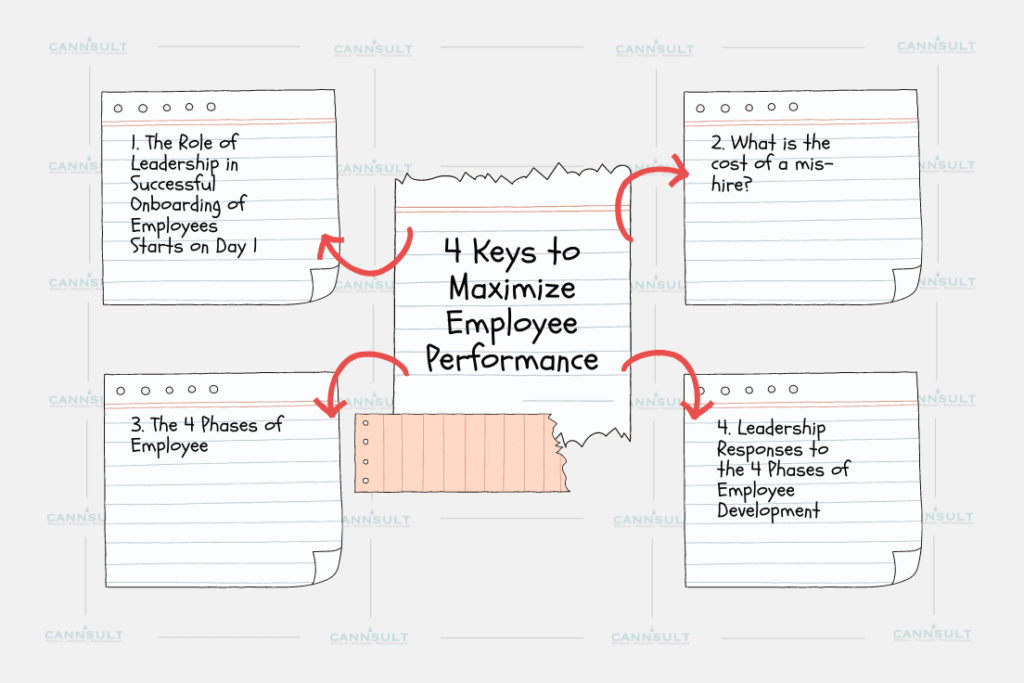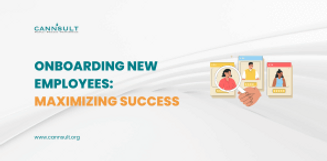4 Keys to Maximize Employee Performance
What’s your best guess at the percentage of employees that are skillfully and thoroughly onboarded when they start a new role or a new job? This is not just about the basics of finding your desk, your computer, and intros to the team. This is about providing the direction and support that a person needs to become an “A Player” in their role.
Think about the times that you have had a significant change in your role OR the times that you have started a whole new role at a new organization. All those in favor of poor or mediocre onboarding, please shrug your shoulders! There is a very predictable path that people go through when facing a new or changed role. Whether it’s the same job with a significant change (for example, a new system, a new org structure, a new leader) or a whole new role, nobody, but nobody starts on day 1 as a highly productive and highly confident performer. What they have is potential. And it’s the job of leadership to turn that potential into a reality.

The Role of Leadership in Successful Onboarding of Employees Starts on Day 1
Most of us can easily recall starting a new position and finding that the tools we need to do the work are not yet ready, the people who are the subject matter experts are spread too thin to give you the help you need when you need it, and there’s a lot of unproductive time waiting to pull the pieces together. This is a failure of leadership and can set our most precious resources up for frustration or failure. In the best case, the employee will figure it out by hook or by crook with a lot of frustration and lost productivity along the way. And in the worst case, the loss of a potentially great resource. Many organizations monitor Employee Retention, but how many calculate the cost of a lost employee? Particularly a new hire!
What is the cost of a mis-hire?
The hiring and onboarding process is more important than the strategy or operations process. If we don’t get the people’s side of things right, then we are extraordinarily limited in our ability to realize the potential of the organization. Lost employees increase expenses and lower profits – not to mention the toll it takes emotionally. To obtain a true picture of the cost of turnover, we also have to factor in indirect costs and the effects on customers.
-
Overtime and over-stretching of current employees
-
Overall lower productivity
-
Loss of business due to poor service levels
-
Expenses related to poor performance
-
Separation costs (like severance, benefits, unemployment, existing interview, outplacement, legal)
-
Replacement Costs (advertising, time, travel, search firm, relocation…)
-
Training and Onboarding costs, the learning curve
The Saratoga Institute estimates the cost of employee turnover to range from 50% to 200% of the employee’s annual salary. On average, a company loses about $1,000,000 with every 10 professional and managerial employees who leave their organization!
Beyond Onboarding Employees: The 4 Phases of Employee Development
There is a very predictable path that humans go through when learning new ways of working, joining a new team, or adapting to change. Consider the last time you learned something new…maybe learning a new application, getting familiar with a new device, starting a new role, or a new job. Think about a specific example as you read through a simple description of the predictable phases.
Phase 1…I’m eager and ready!
The first phase is typically excitement and eagerness, especially if it’s a promotion or a new job. We are eager to get started and excited to quickly demonstrate value. We don’t know the specifics of how the organization or processes or tools work, but we’ve got some great transfer skills and experience and we’re ready to go!
Phase 2…What the hell did I get myself into?!
The second phase happens as we start to get familiar with the change. Balls are being dropped and mistakes are being made. Frustrations build as we discover all the things that don’t work and all the support that is not in place. How does it feel to be at this phase? It feels overwhelming like we’ve made a horrible decision being here, expectations do not match reality. We keep chugging along as we get resumes back out and re-engage our network. This is a critical point where many great resources leave. Or worse yet, where many miss-hires stay…at a poor performance level…for a long time.
Phase 3…I think I got this now
If we get through the disillusionment of Phase 2 and manage to learn how to get the job done, we will arrive at a place where we are confident that we can competently perform. When we are here, we might need to do double-checks, look things up, or ask for assistance once in a while. Or maybe run ideas past a trusted advisor before completion, but we’re actually on pretty solid ground.
Phase 4… It feels great to be a top performer!
If we are fortunate enough to realize this phase, we will have achieved an expert level in the role AND we are confident, engaged, and fulfilled. At this phase, we are able to create and deliver creative solutions, continually improve the process and support and inspire others in the organization.
The key to efficiently and effectively progressing to the most productive phase is the ability of leadership to provide the necessary level of support and direction when and how it’s needed.
Beyond Onboarding Employees: Leadership Responses to the 4 Phases of Employee Development
The key to developing highly engaged great performers is to provide them with what they need as they progress through the phases of learning or change. In short, we can summarize this with particular leadership actions required at each phase. If you’re an employee, then you must know what to ask for. And if you’re the leader, you must recognize the needs so that you can deliver. It doesn’t matter what your “style” is. The leader needs to flex as the employee progresses through the change.
Read more: Employee Retention Toolkit; 5 Process Improvement Tools to Aid Employee Retention in 2023
1. Phase 1…”I’m eager and ready!”: Needs Specific Direction
At this phase, the employee needs to know specific, measurable goals and timelines. They need specific direction on what tools to use, how to work within the process, how to identify and solve problems, how to escalate issues, and where to go for help. Phase 2 is coming, but if we handle this initial phase well, it can be short and easy. But, if we do a poor job here in Phase 1, then Phase 2 will happen fast and ugly.
2. Phase 2…”What the hell did I get myself into?!”: Needs a lot of Direction and Discussion
At this point, the employee is feeling overwhelmed, and frustrated and is fantasizing about how to get out of the situation. They need clear and specific direction (as they did in Phase 1), but now they also need a lot of support. That support comes in the way of discussions, and explanations, allowing venting of frustrations, and providing perspective and reassurance. If these needs aren’t met, there will be great losses of resources of all kinds. We can expect poor performance, low employee engagement, and retention. However, if needs are met at this phase, the person will quickly move on to Phase 3, which is where competency and productivity begin to take hold.
3. Phase 3…”I think I got this now”: Needs a sounding board/safety net
By this time, the employee has developed competence in the task or goal. They are coming fresh out of Phase 2, so they are a bit unsure. At this phase, they no longer need specific guidance on how to do the task (they know that now!). They just need a bit of time to work through their work and do some double-checks. They need a mentor or a leader who can act as a sounding board or a safety net to give them that last boost of confidence so that they can move on to the final phase.
4. Phase 4…”It feels great to be a top performer!”: Needs autonomy and growth
This is where we reach great performance and amazing levels of employee engagement. This person no longer needs detailed direction and they don’t have many frustrations or issues to vent and discuss. Tasks or goals can be delegated to them and they’ll handle it…happily and confidently! They need clear goals and autonomy and then they need to be challenged and allowed to grow even further.
When you begin to recognize these phases and either ask for the help that you need or know-how and when to provide that support to a new hire or employee, then and only then will you realize the full potential of our human resources. How much productivity is left on the table due to poor onboarding? How much employee engagement and joy at work has been lost because we didn’t know what to ask for or what was needed?
Try these simple steps to realize more productivity and joy!









